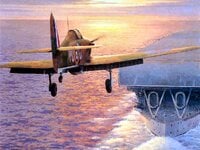Off Norway they were landing with 40kts of wind over the deck.
True, but you have 10 RAF pilots, none who had never made a carrier landing before. They went 10/10 landing Hurricanes without any modifications for naval use at all. No strengthened fuselage, no arrestor gear. no under carriage modifications nada. Brown seems overly critical of the Sea Hurricane, especially considering how well it performed both landing and taking off from carriers.
Last edited:

